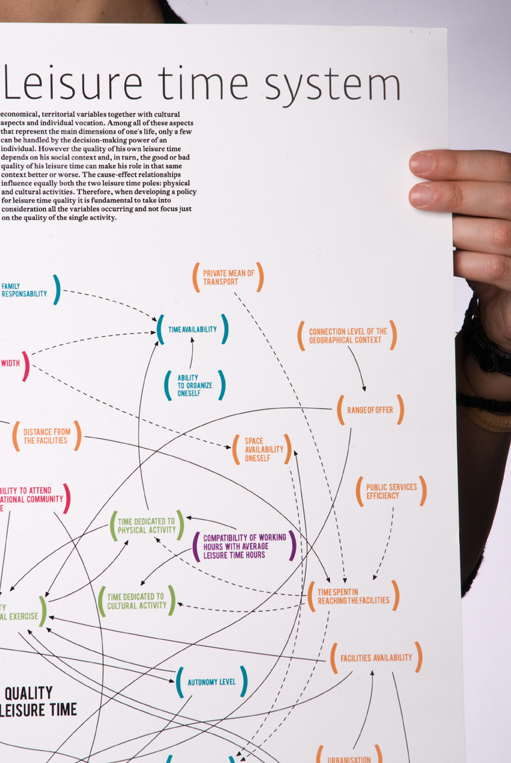The map shows the leisure time system and the variables that are related to it. We considered "nodal" the "quality of leisure time" variable, because it reflects indicators that can be relevant in decision-making processes on the system. The leisure time quality is influenced by variables divided in 5 main clusters: leisure time, individual variables, social variables, economic variables, geographical and housing context.
The relationships occurring between the variables are of two kinds: each element can influence another in a directly or indirectly proportional way (positive/negative link).
By mapping the system what comes out is that for a correct evaluation of the leisure time quality it is essential to analyze the entire range of variables interacting in the system: social, economical, territorial variables together with cultural aspects and individual vocation. Among all of these aspects that represent the main dimensions of one's life, only a few can be handled by the decision-making power of an individual. However the quality of his own leisure time depends on his social context and, in turn, the good or bad quality of his leisure time can make his role in that same context better or worse. The cause-effect relationships influence equally both the two leisure time poles: physical and cultural activities. Therefore, when developing a policy for leisure time quality it is fundamental to take into consideration all the variables occurring and not focus just on the quality of the single activity.
By mapping the system what comes out is that for a correct evaluation of the leisure time quality it is essential to analyze the entire range of variables interacting in the system: social, economical, territorial variables together with cultural aspects and individual vocation. Among all of these aspects that represent the main dimensions of one's life, only a few can be handled by the decision-making power of an individual. However the quality of his own leisure time depends on his social context and, in turn, the good or bad quality of his leisure time can make his role in that same context better or worse. The cause-effect relationships influence equally both the two leisure time poles: physical and cultural activities. Therefore, when developing a policy for leisure time quality it is fundamental to take into consideration all the variables occurring and not focus just on the quality of the single activity.
Format: A2 Print







